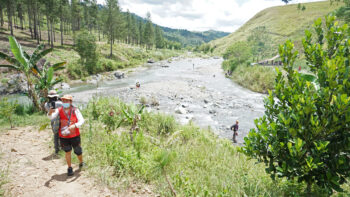
10th of 16 parts
(Done in 1992 at Iligan City, published initially as two versions. First as the abbreviated edition published by The Minority Rights Group, London entitled The Lumad and Moro of Mindanaw, July 1993. The Philippine edition carrying the full draft was printed by AFRIM in Davao City 1994. This was later updated in 2003, summarized in an epilogue. This is the third revision, now with an expanded Epilogue.)
Part X
Chapter 4. Among the Lumad: T
Acknowledged as the chieftain of the Bagobo tribe in Davao, Datu Inong Awe was well over 90 years old when he led a Bagobo tribal delegation to Manila to protest against the planned drilling of geothermal wells at the Mt. Apo area by the Philippine National Oil Company (PNOC). He died the year after, when PNOC was just warming up.
Weighed down with foreign debts, payment for which constitutes close to fifty percent of the national budget, the Philippine government has been incessantly searching for every possible source of natural energy, be it oil or geothermal. This is the task of the PNOC. And Mt. Apo offers vast geothermal resources.
Apo Sandawa
A dormant volcano, Mt. Apo in Bagobo folk tradition has been the home of Mandarangan, chief of the Bagobo war gods, also called “the God of the Sky for men”. Tribal historians also claim that the human race sprang from the couple Toglai and Toglibon who lived in the same mountain. Apo Sandawa to the Bagobos, Mt. Apo is a sacred mountain. But PNOC saw only the vast store of geothermal energy held in its belly, awaiting to be tapped for modern requirements.
In the Long Line of Fighting Leaders
Datu Inong Awe belonged to the long line of fighting leaders. His father was cousin to Datu Tongkaling, the acknowledged Bagobo datu of Sibulan community east of Mt. Apo when the American colonizers came. Between 1905 and the second world war, these same colonizers allowed Japanese corporations to open up large tracts of land in Davao into huge and profitable abaca plantations. Some 600 Japanese plantation workers perished in Bagobo hands between 1918 and 1938 when they ruthlessly expanded their abaca plantations into Bagobo tribal lands. Several of their own warriors, called magani, died in the hands of the Japanese soldiers during the second world war. But it seems their fight did not end with the departure of the last of the Japanese Imperial Army. Now, their enemy is the PNOC, acting in the name of the national government, which in turn is acting in the name of national development.
Geothermal Potential of Mt. Apo
Much has transpired since that initial show of opposition led by Datu Inong Awe. Since Mt. Apo was the tallest mountain in the Philippines (2,954 meters above sea level) and is the habitat of the monkey-eating eagle, it was declared a national park together with the surrounding area totaling 72,814 hectares, by executive proclamation on 9 May 1936. Later it became known also as the habitat of the famous Philippine monkey-eating eagle. In the early 80s, it was also listed as a Heritage Site by the Association of Southeast Asian Nations (ASEAN). It is also registered in the United Nation’s list of National parks and Equivalent Reserves.
Early Attempts to Explore Mountain
Since 1983, the PNOC had tried in vain to obtain permits to explore the energy potentials of Mt. Apo. The Revised Forestry Code clearly provided that “National parks shall not be subject to exploitation and other activities of a commercial nature.” With unusual persistence, PNOC was finally able in 1987 to secure an Environmental Clearance Certificate (ECC) from the National Environmental Protection Council (NEPC), now the Environmental Management Bureau (EMB). This was followed by a two-year exploration period, despite opposition from the Department of Environment and Natural Resources (DENR), which proved beyond doubt the existence of the vast power potential of the mountain.
The PNOC reportedly plans to dig a total of 170 wells as part of the ten-year power development program of the National Power Corporation (NAPOCOR). These wells will in turn supply steam to four power plants. The target is to produce 220 megawatts of electricity.
In the overall perspective of the power development program of NAPOCOR, its ultimate aim is for geothermal energy to constitute 27.4% of the nation’s power needs by the turn of the century.
(MindaViews is the opinion section of MindaNews. A peace specialist, Rudy Buhay Rodil is an active Mindanao historian and peace advocate)
TOMORROW: Chapter 4. Part XI
Stemming Tide of Tribal Opposition







